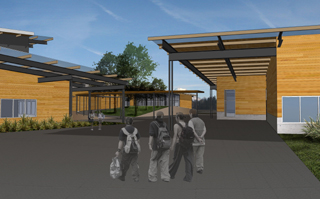
DJC.COM
August 28, 2008
Tribal schools expand role preserving native cultures
Mahlum Architects

Reifert
|
Native Americans are showing increased interest nationwide in building schools that instill in their children a deeper understanding of their tribal culture and connection to the environment.
Recognizing the importance of preserving traditions that might otherwise be lost on younger generations, Indian groups from New York state to Washington state are making bold strides to restore cultural pride and understanding through innovative school designs and programs.
Design with meaning
A new K-12 school now under construction near Auburn by the Muckleshoot Indian Tribe will be rich in symbolism, referencing the geography of the tribe’s land between two rivers as well as the path that children take toward adulthood. The school will also pay tribute to the four seasons.

Photo courtesy of Mahlum The Muckleshoot Indian Tribe’s K-12 school near Auburn, now under construction, will be housed in a four-building complex rich in symbolism. The design of each building will support tribal identity and traditions.
|
The design of each building in the four-building complex will support tribal identity and traditions. And each building will represent a step in the development of a child, a deliberate hierarchy that brings children into contact with older children and ultimately adults. An exterior fire pit and story circle as well as a freestanding fireplace in the library will support the tribe’s oral tradition.
The elementary school building will evoke images of spring — chinook, new fawns, first winds, new foliage of greens and yellows — while the middle school building will reference summer — sockeye, fishing, berry picking, dark greens and berry reds. The high school building will reflect autumn — coho, fishing, hunting, and the fall colors of red, yellow and orange.
The fourth building will include a commons, library and gymnasium that can accommodate large potlatches or community celebrations. These public spaces will convey images of steelhead, storytelling, dancing and the winter colors of smoked salmon, dark greens and browns. All public spaces will open onto a central courtyard that looks toward Mount Rainier and the Cascade foothills.
The buildings will be timber-framed and clad with cedar, reflecting the tribe’s tradition of building with wood — a common practice among Native Americans living in forested areas. Landscaping will incorporate wetlands and plants native to the Muckleshoot Prairie that support the teaching of traditional crafts — cattails for mats, firewood fluff for blankets of goat hair, berries for food and tea, willows for fish weirs.
The Chief Leschi School of the Puyallup Tribe likewise makes extensive use of wood.
A sacred circle at the center of the campus acknowledges an orientation of the four directions and a belief that life is a journey from east to west, infancy to old age, as the sun crosses the sky. The building forms that radiate from the circle incorporate universal elements of the sea, the valley and mountain into a unified whole.
Some members of the community see a raven in the building plan, others a play of solid and void that represents bone and tissue in Native American art. Still others find a natural flow of young to old in the organization of the functional parts, reflective of the desire in Native American culture to find harmony and balance. Nothing in the design is extraneous — everything has meaning.
Consulting with elders
The elders’ desire for more relevant school buildings is driven in part by the ability to finance construction fully or in part from gaming money, although some funds also come from federal sources. The Indian Community School in Franklin, Wis., is unusual in that it is funded totally by a gaming agreement between the state and the Potawatomi Nation, which operates a successful casino.
In our experience at Mahlum Architects we have found it essential in all our tribal projects to consult with the elders on elements of the design. This attitude is in marked contrast to non-Indian schools, where members of a neighboring community might voice their views but little effort is made by architects to find out what the oldest citizens in the area think.
Elders increasingly recognize that if richness of the native culture is to be passed on, they need to involve the younger generation in tribal rituals, beliefs, arts, crafts and history. For this generation, the physical facility and how it works is key to that process. All buildings should say something about the place where the native community lives.
Physical roots
More than most non-natives, tribal communities value their geographical place because it is inevitably linked with their culture. The spirituality of the place informs the communities’ beliefs and rituals.
Wisconsin’s Indian Community School meanders ribbon-like for a quarter of a mile on a 124-acre site that includes wetlands, hills, prairies and woodlands.
At one end of the building, an amphitheater around a tree symbolizes the tradition of oral history for the Oneida, Menomonee and Stockbridge-Munsee Indian tribes. Metal beams in the ceiling near the main doorway represent the migratory paths of birds and a breakout classroom overlooks wetlands.
The childcare center for the Muckleshoot Indian Tribe invites children to explore and interact with nature and the built environment — bridges and water-quality structures that demonstrate traditional salmon weirs, interpretative trails for exploring indigenous plants, and tactile castings in the floor.
The Seneca Nation of Indians in western New York is reaffirming its storytelling culture as it considers plans for an early childhood learning center. They will look for ways to represent stories of significance for each season on the walls of the building. The school will provide exposure in both English and the native language.
Many eco-friendly features are incorporated into Indian school design — natural daylighting, rain gardens, energy-efficient heating and lighting, nontoxic paints, recycled materials, sometimes roof gardens. But it is the physical environment that heavily influences the design because it informs so much of the community’s rituals and culture.
As elders seek school designs that best reflect the traditions they want to pass on to younger generations, they share the attitude of a Kickapoo Indian chief who once reflected, “By our houses you will know us.”
Gerald “Butch” Reifert, managing partner of Mahlum Architects, has directed many assignments for K-12 schools, college and universities.
Other Stories:
- Can good design boost the case for school consolidation?
- Spend more now to save big in the long run
- Nature’s obstacles force fresh thinking in Everett
- Green goals guide UW’s Architecture Hall renovation
- What the future holds for school design
- UW building to get B-school students mingling
- Colleges expand to meet health care demand
- Northwest University answers call for nurses
- A science building that goes easy on energy
- The next generation of American schools
- 7 questions project managers should ask about BIM
- Mount Rainier inspires Orting Middle School design
Copyright ©2009 Seattle Daily Journal and DJC.COM.
Comments? Questions? Contact us.